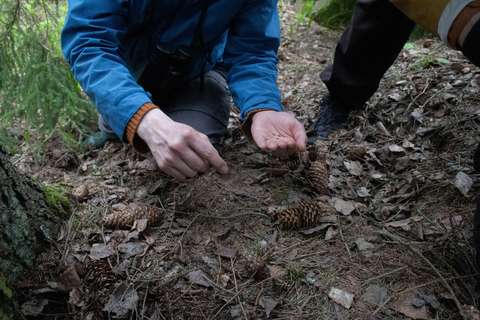Espoo surveyed bird rocks, underwater nature and endangered habitats - collecting data is an important part of sustainable city development

The 2024 nature surveys revealed, for example, valuable oak groves and the presence of vibrant bladderwrack (Fucus vesiculosus) beds in the Baltic Sea off Espoo. The surveys will help Espoo protect its most important natural sites, even as the city grows. Nature surveys will continue this year.
“The city’s growth and related decision-making must be based on knowledge. Nature surveys provide us with important information about Espoo’s nature and its condition. This allows us to direct construction to areas where there are no significant nature values. At the same time, we safeguard valuable habitats,” says Tia Lähteenmäki, Environmental Specialist at the City of Espoo.
Espoo surveyed nature both below and above the waves
In 2024, Espoo Environmental Protection commissioned four nature surveys:
- Bird rocks in the archipelago: A breeding bird population of nine bird rocks was surveyed off Soukka, Matinkylä and Westend. On the basis of the survey, Espoo Environmental Protection will investigate whether the Soukanluoto and the Linholm rocks off Westend could be made into nature reserves, as they are home to valuable birdlife such as eiders and terns.
- Underwater habitats: The underwater survey was the first of its kind in Espoo. It found nature elements such as highly endangered bladderwrack, which indicates good water quality. Fry thrive in the shelter of bladderwrack beds. The survey provides a basis for the protection of underwater nature, which has so far been minimal.
- Small water survey: More data on Espoo’s ponds and springs was needed to guide conservation work and land use. No springs were found in the surveys because of changes in land use or misinterpretations in old nature surveys. However, the surveys identified ponds with a rich range of plants, birds and dragonflies. These included Igelträsk, Lillträsk, Lullampi, Mustalampi and Pikku-Sorlampi.
- Endangered habitats: In southern Espoo, groves, bogs and small water bodies were surveyed. The survey found nationally threatened habitats such as hazel and oak groves.
In addition to the nature surveys commissioned by Environmental Protection, dozens of other city departments carried out surveys for planning and park design, for example. Nature surveys are always commissioned from external nature surveyors, which guarantees the impartiality of the surveys.
Espoo has also just introduced an innovative new nature information system that brings all nature surveys together in one place and makes them more useful for land use planning. No other municipality in Finland has such a comprehensive system for receiving and managing nature-related information.
This year, forests, traditional landscapes and running waters will be surveyed
In 2025, Espoo will continue to survey endangered habitats, now focusing on rock forests and dry northern forests in western Espoo and Espoo Central Park. The plant species of traditional landscapes, i.e. old meadows, will also be surveyed. The status of the rivers Glimsinjoki, Gräsanoja and Mankinjoki will be examined in a running waters survey.
Some of the sites will also be assessed for their restoration potential, i.e. where and how it would be worthwhile to restore natural areas that have been degraded by human activity.
The City of Espoo has been commissioning nature surveys for decades, and the amount and detail of information has increased over time. The surveys will help the city to implement the Nature-wise Espoo roadmap, which aims to improve biodiversity in Espoo.